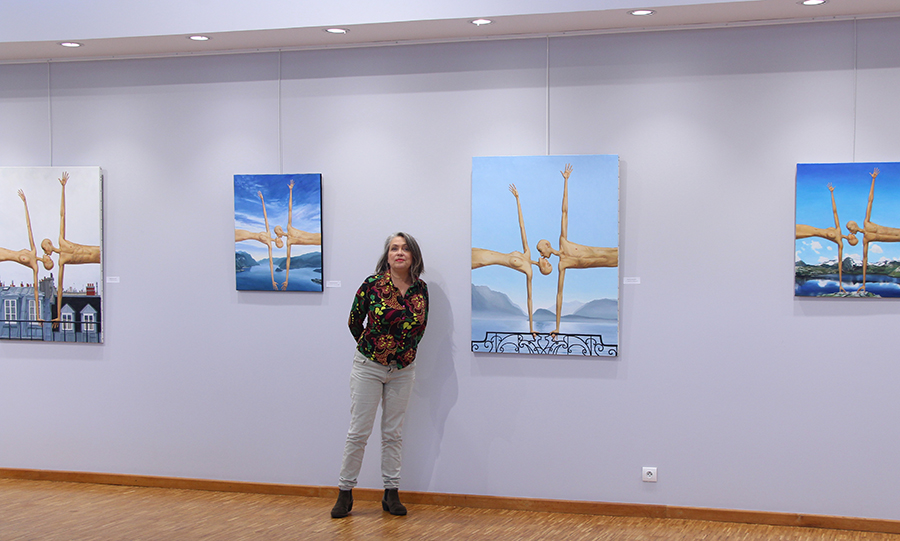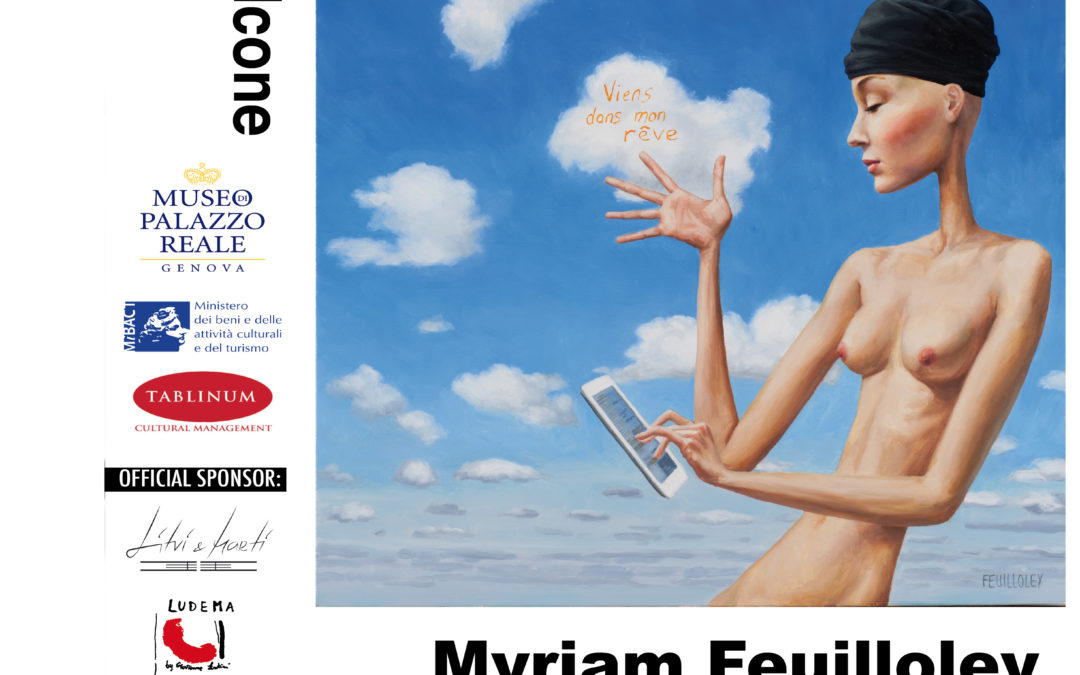(ITA)
L’arte di Myriam Feuilloley può rievocare in noi suggestioni di matrice Surrealista che, però assumono immediatamente un linguaggio del tutto personale e autonomo. Questo perché Feuilloley riesce ad appellarsi in modo del tutto spontaneo a quella che è la dimensione simbolica dell’essere in modo che nel suo linguaggio dominino i meccanismi dell’inconscio e del simbolico.
La tela diventa il filtro attraverso il quale l’artista analizza la società contemporanea e la trasfigura sottoponendola ad un’acuta analisi introspettiva per poi metterla di fronte allo spettatore e innescare in lui una riflessione sul mondo contemporaneo e sull’approccio con cui ognuno di noi è chiamato a misurarsi.
Ed ecco che nelle tele di Myriam troviamo personaggi scevri di caratterizzazione fisica, che ci appaiono finalmente per ciò che sono, attraverso un processo di esteriorizzazione della propria interiorità: scompaiono segni distintivi come i capelli o gli abiti, quasi a voler sottolineare la mancanza dei soggetti di poter affermare un’identità fisica chiara e consapevole senza fare appoggio ad accessori e orpelli che si fanno veicolo di riflessione sulle modalità in cui l’individuo è chiamato a confrontarsi con il mondo esterno ma anche sui suoi tentativi di trascendere da esso.
Attraverso differenti livelli di lettura della tela l’artista lancia una vera e propria sfida allo spettatore e lo costringe a mettere in discussione se stesso in qualità di osservatore e al contempo soggetto.
Ed eccoci così di stimolati a intrapredere una riflessione chiara e diretta in merito al rapporto dell’uomo con la propria contemporaneità: incapace di andare oltre un certo materialismo esistenziale, sterilmente trincerato in se stesso.
Nessuno spazio per guardare oltre se stessi, ogni orizzonte sembra ormai occluso: la necessità di trascendere da sé si realizza sterilmente attraverso l’utilizzo ossessivo di tablet e smartphone: i soggetti dipinti da Feuilloley uno accanto all’altro sullo sfondo di un meraviglioso cielo azzurro appaiono troppo concentrati a contemplare la loro esistenza intrappolata in uno schermo LCD per poter alzare lo sguardo e intraprendere un dialogo umano. Il bisogno di trascendenza si banalizza in un’urgenza di evasione da se stessi e si smarrisce in una tentativo di sublimazione tecnolgica sterile e inconsistente.
Ma davvero le nostre “trascendenze contemporanee” si riducono a questo estraniante dialogo in cui sembra proprio siano andati smarriti non solo i rapporti con i nostri simili ma persino la nostra autoconsapevolezza? Difficile dare delle risposte a queste domande. Nelle tele esposte alla fine di questo percorso l’artista lascia però trapelare un messaggio positivo: forse è ancora possibile risvegliare in noi il prezioso che sembra giacere sotto la coltre di una vita vissuta al di fuori di se stessi. Il “come” spetta a noi scoprirlo trovando il coraggio di metterci realmente in gioco.
La nostra sete di Trascendente, posta sulla bilancia della vita contemporanea, infine raggiungerà il suo peso specifico e, mettendo le ali alla nostra anima, riusciremo forse a librarci al di fuori della prigione del narcisismo e dell’autoreferenzialità per riprendere un viaggio tutto nostro alla ricerca di quel mistero prezioso che rende la vita di ciascuno di noi unica e ineguagliabile.
(ENG)
Myriam Feuilloley’s art can evoke in us suggestions of a surrealist matrix, which however assume at once a language which is completely personal and autonomous. This occurs because she manages to appeal to that which is a symbolic dimension of the being in such a way that unconscious and symbolical mechanisms dominate her language.
Her painting becomes a filter through which the artist analyses contemporary society; she transfigures it by subjecting it to an acute introspective analysis and then placing it in front of the spectator thus triggering a reflection of the contemporary world and on the approach that each of us is called upon to measure.
We find, in her paintings, personages void of physical characterisation which finally appear to us for what they are by means of an exteriorization process of their own inwardness: distinctive signs disappear such as hair or clothes, almost wishing to underline the lack of subjects so as to affirm a clear physical, conscious identity without relying on accessories and disguises which are a means of reflecting the ways in which the individual is called upon to confront himself with the world outside but also his attempts to transcend it.
The artist launches a real challenge to the spectator through different levels of interpretation, and forces him to examine himself both for his own qualities as an observer and, at the same time, as a subject.
Myriam Feuilloley’s paintings grant us a clear and direct reflection concerning relations with man with his own contemporaneity: unable to go beyond a certain existential materialism, fruitlessly entrenched in himself.
No space to look at beyond ourselves, each horizon even seems obstructed: the necessity to go beyond oneself is fruitlessly realised with the obsessive usage of tablets and smartphones: the subjects painted by Feuilloley, one next to the other on a background of wonderful blue sky, appear to be too taken up with contemplating on their existence trapped in a LCD screen, rather than to raise their eyes and start a human dialogue. The need of transcendency is banalised in the urgency of evading and losing ourselves in an attempt of sterile and in consistent technical sublimation.
But do our comtemporary transcendencies really reduce themselves to this estranged dialogue in which it would appear that not only our relations with our fellow men but even our own awareness have been lost? It is difficult to answer these questions, but in the paintings at the end of the exhibition the artist releases a positive message: perhaps it is still possible to reawaken within ourselves something precious under the blanket of a life outside of ourselves. It is up to us to find it by finding the courage to really trying to participate.
Our thirst for Transcendency, in balance with contemporary life, will, at the end, reach its specific weight and by adding wings to our soul, we will perhaps manage to free ourselves outside of this prison of narcissism and of self-reference to continue a special journey in search of that precious mystery which makes the life of each of us both unique and incomparable.
ABOUT MYRIAM FEUILLOLEY

